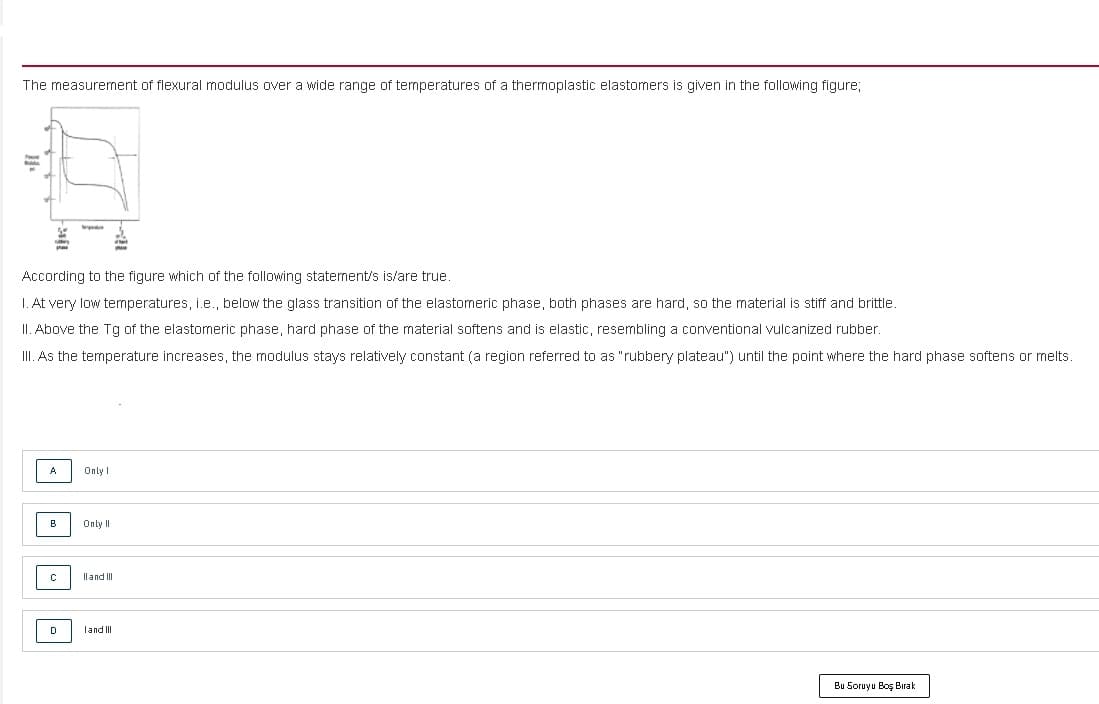The measurement of flexural modulus over a wide range of temperatures of a thermoplastic elastomers is given in the following figure; According to the figure which of the following statement/s is/are true. 1. At very low temperatures, i.e., below the glass transition of the elastomeric phase, both phases are hard, so the material is stiff and brittle. II. Above the Tg of the elastomeric phase, hard phase of the material softens and is elastic, resembling a conventional vulcanized rubber. II. As the temperature increases, the modulus stays relatively constant (a region referred to as "rubbery plateau") until the point where the hard phase softens or melts.
The measurement of flexural modulus over a wide range of temperatures of a thermoplastic elastomers is given in the following figure; According to the figure which of the following statement/s is/are true. 1. At very low temperatures, i.e., below the glass transition of the elastomeric phase, both phases are hard, so the material is stiff and brittle. II. Above the Tg of the elastomeric phase, hard phase of the material softens and is elastic, resembling a conventional vulcanized rubber. II. As the temperature increases, the modulus stays relatively constant (a region referred to as "rubbery plateau") until the point where the hard phase softens or melts.
Chemistry
10th Edition
ISBN:9781305957404
Author:Steven S. Zumdahl, Susan A. Zumdahl, Donald J. DeCoste
Publisher:Steven S. Zumdahl, Susan A. Zumdahl, Donald J. DeCoste
Chapter1: Chemical Foundations
Section: Chapter Questions
Problem 1RQ: Define and explain the differences between the following terms. a. law and theory b. theory and...
Related questions
Question

Transcribed Image Text:The measurement of flexural modulus over a wide range of temperatures of a thermoplastic elastomers is given in the following figure;
According to the figure which of the following statement/s is/are true.
1. At very low temperatures, i.e., below the glass transition of the elastomeric phase, both phases are hard, so the material is stiff and brittle.
II. Above the Tg of the elastomeric phase, hard phase of the material softens and is elastic, resembling a conventional vulcanized rubber.
II. As the temperature increases, the modulus stays relatively constant (a region referred to as "rubbery plateau") until the point where the hard phase softens or melts.
A
Only I
B
Only I
Il and II
D
land II
Bu Soruyu Boş Birak
Expert Solution
This question has been solved!
Explore an expertly crafted, step-by-step solution for a thorough understanding of key concepts.
Step by step
Solved in 2 steps

Knowledge Booster
Learn more about
Need a deep-dive on the concept behind this application? Look no further. Learn more about this topic, chemistry and related others by exploring similar questions and additional content below.Recommended textbooks for you

Chemistry
Chemistry
ISBN:
9781305957404
Author:
Steven S. Zumdahl, Susan A. Zumdahl, Donald J. DeCoste
Publisher:
Cengage Learning

Chemistry
Chemistry
ISBN:
9781259911156
Author:
Raymond Chang Dr., Jason Overby Professor
Publisher:
McGraw-Hill Education

Principles of Instrumental Analysis
Chemistry
ISBN:
9781305577213
Author:
Douglas A. Skoog, F. James Holler, Stanley R. Crouch
Publisher:
Cengage Learning

Chemistry
Chemistry
ISBN:
9781305957404
Author:
Steven S. Zumdahl, Susan A. Zumdahl, Donald J. DeCoste
Publisher:
Cengage Learning

Chemistry
Chemistry
ISBN:
9781259911156
Author:
Raymond Chang Dr., Jason Overby Professor
Publisher:
McGraw-Hill Education

Principles of Instrumental Analysis
Chemistry
ISBN:
9781305577213
Author:
Douglas A. Skoog, F. James Holler, Stanley R. Crouch
Publisher:
Cengage Learning

Organic Chemistry
Chemistry
ISBN:
9780078021558
Author:
Janice Gorzynski Smith Dr.
Publisher:
McGraw-Hill Education

Chemistry: Principles and Reactions
Chemistry
ISBN:
9781305079373
Author:
William L. Masterton, Cecile N. Hurley
Publisher:
Cengage Learning

Elementary Principles of Chemical Processes, Bind…
Chemistry
ISBN:
9781118431221
Author:
Richard M. Felder, Ronald W. Rousseau, Lisa G. Bullard
Publisher:
WILEY